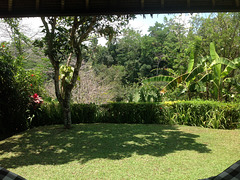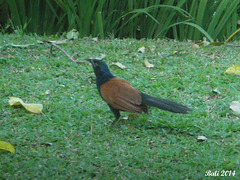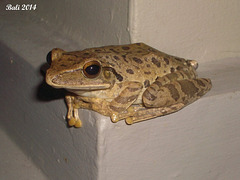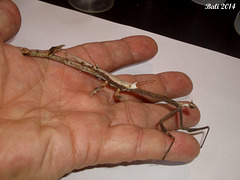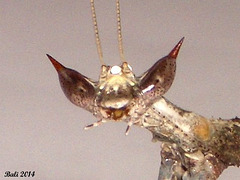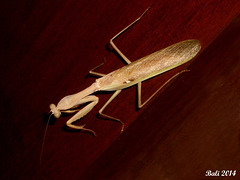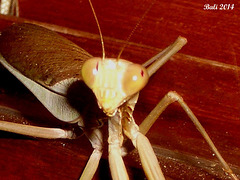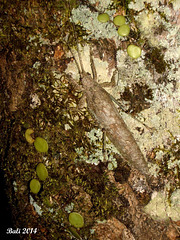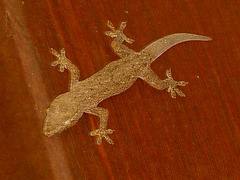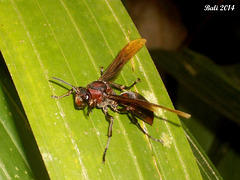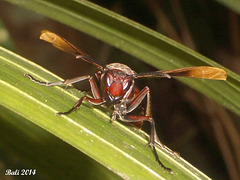
2014 Bali, Indonesia Scenes & Wildlife
Folder: Far East
Pictures from our visit to the hotel Maya Ubud, inland at Bali. The hotel is on the side of a river valley filled with lush vegetation and having tracks along the river side. Chosen because of the possibility of interesting wildlife here. As well as a wide range of general wildlife, we had over 60 species of Moths recorded at our garden villa, which are now in a companion Album in this folder.
19 The Front Of Our Villa
| |
|
Also showing our Moth Trap hung on the Verandah area. As in many other places, the Ants quickly became aware of the small flies which had flown into the lamps every night, and had then fallen below the trap, and amazingly most of these had been removed by dawn. To avoid the trap being over-run and the moths being attacked, we hung it from the roof structure with string which had been smeared at the limits with Vic Menthol gel which formed an effective barrier to crawling insects. A similar application on the electricity cable made the trap isolated from this problem, although the occasional Praying Mantis had to be deported when found.
20 Pat At Our Villa Entrance From Gardens
| |
|
The path down from the entrance door was an established planting of a variety of plants and creepers, which, together with the privacy borders of the front garden of the villa, provided an interesting search area for the local wildlife, some of which are shown in the following pictures.
21 View Into Valley From Our Villa
| |
|
A general view from the villa verandah. The area was a source of varied wildlife calls day and night, and in the day, Cicadas were so loud that you could hardly hear yourself talk.
22 Bath Time In Our Pool
| |
|
Our pool's shallow sloped perimeter was a regular visiting place for the local small birds having a daily bath.
23 Centropus sinensis (Greater Coucal)
| |
|
This fairly large bird (375mm beak to tail tip) came to our garden a few times during our stay, particularly foraging for fruits on the main tree. My Thanks to "Rockwolf" for suggesting the Genus.
24 Duttaphrynus melanostictus (Common Asian Toad)
| |
|
One of a number of Common Asian Toads which could be seen on the lawn at night in the Villa Garden.
25 Polypedates leucomystax (Common Tree Frog)
| |
|
A common Tree-frog quickly recognised that our Moth Trap was a great source for food, so regularly staked out the area at the base of one of the verandah pillars.
26 Polypedates leucomystax (Common Tree Frog)
| |
|
|
Another Tree-frog sitting on point duty at the end of our towel frame, another favourite stake-out area when the Trap was operating.
27 Paratoxodera cornicollis (Giant Stick Mantis)
| |
|
Mantidae, Toxoderinae
My thanks to Judith Marshall (NHM, London Rtd.) for pointing me to the identification.
A strange bundle of thin twigs was found moving slightly on the floor near where the Moth Trap had been operated one morning. A close look at it showed that the bundle was being dragged off by a small group of tiny Ants, and it became obvious that the bundle was actually a living thing struggling with the Ants. I rescued it, and found that it was actually a Praying Mantis with the tail pulled up over its back. Strangely, it seemed that the Mantis had been affected by insecticide of some sort, as it was almost dead, and subsequently died later. Apparently a species not seen very often.
28 Paratoxodera cornicollis (Giant Stick Mantis) F…
| |
|
The amazingly shaped head of this Twig Mantis, showing the strange adaptations to create the twig mimicry.
29 Hierodula sps.
| |
|
An active hunter around our Moth Trap which had to be driven off a number of times.
My thanks to Judith Marshall (NHM Rtd.) for pointing to the Genus. Unfortunately there are around 50 species in this Genus known, so it is difficult to tie the species down so far.
30 Hierodula sps. Face
| |
|
I'm always fascinated that insect eyes usually show a dark spot as though they have a "pupil" showing their attention direction. However, there are no moving parts to the eyes, and I understand it is formed by you looking down the particular ommatidia pointing towards you. Why does this particular insect have the spots as though it is looking almost over its shoulder, which should not be seen from the classic eye structure?
My thanks to Judith Marshall (NHM Rtd.) for pointing to the Genus. Unfortunately there are around 50 species in this Genus known, so it is difficult to tie the species down so far.
31 A Strange Visitor under the Trap one Night
| |
|
|
|
This strange insect, grey and very flattened, was found on the floor under the trap one night. An email for help to Judith Marshall, a retired Orthoptera curator at the British Natural History Museum resulted in the information that it was a bark cricket in the family Tettigoniidae, Pseudophyllinae, and a Sathrophyllia sp. which is known to occur throughout the Oriental region.
32 Bark Cricket Returned to Tree Trunk
| |
|
It seemed at home when I put it onto the trunk in the evening after dark, but didn't really match the site in colour. However, it crept up the trunk, so I suppose it finally found the right background for its safety.
33 A large Gecko hanging around the roof over the…
33 Hemidactylus frenatus (Asian House Gecko)
| |
|
Many of these small Geckos could be seen everywhere, but they had to be on their toes as the large Geckos seemed to judge them as food as much as anything else. This example seems to have lost its tail in a close call some time ago, as there is a prominent joint at the base, and the tail actually seems small for the individual.
34 A 25mm Long Hunting Wasp on Our Hedge
| |
|
|
This quite impressive wasp appeared around the hedge many times, and seemed quite happy to let me photograph it.
35 Face to Face With Our Wasp
| |
|
With its prominent red-brown "nose", I suppose this wasp should be called "Rudolph". :)
Jump to top
RSS feed- Latest items - Subscribe to the latest items added to this album
- ipernity © 2007-2024
- Help & Contact
|
Club news
|
About ipernity
|
History |
ipernity Club & Prices |
Guide of good conduct
Donate | Group guidelines | Privacy policy | Terms of use | Statutes | In memoria -
Facebook
Twitter



